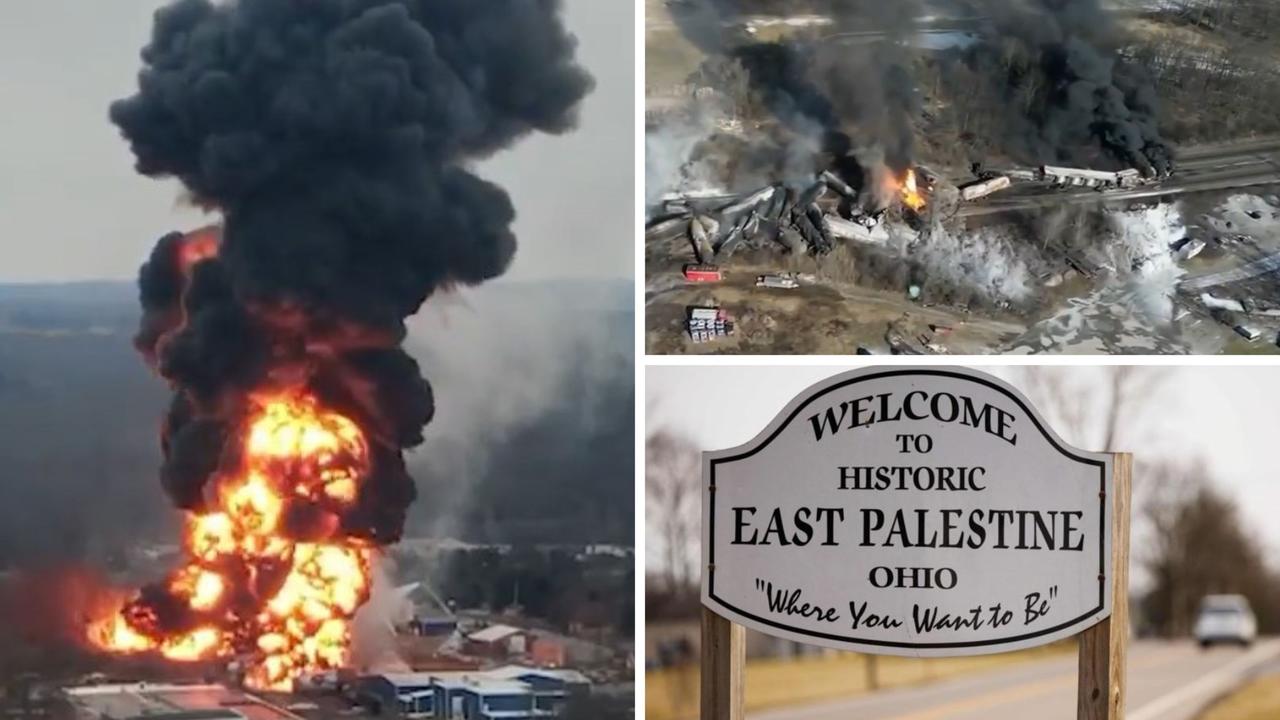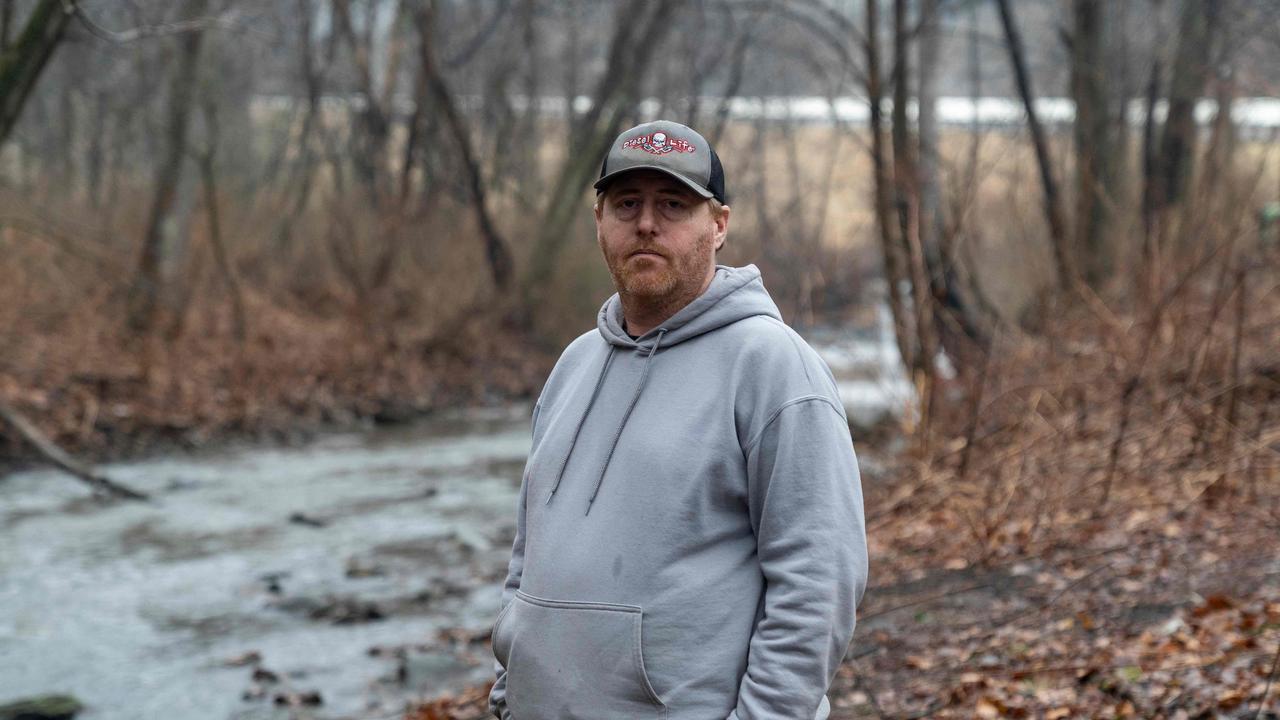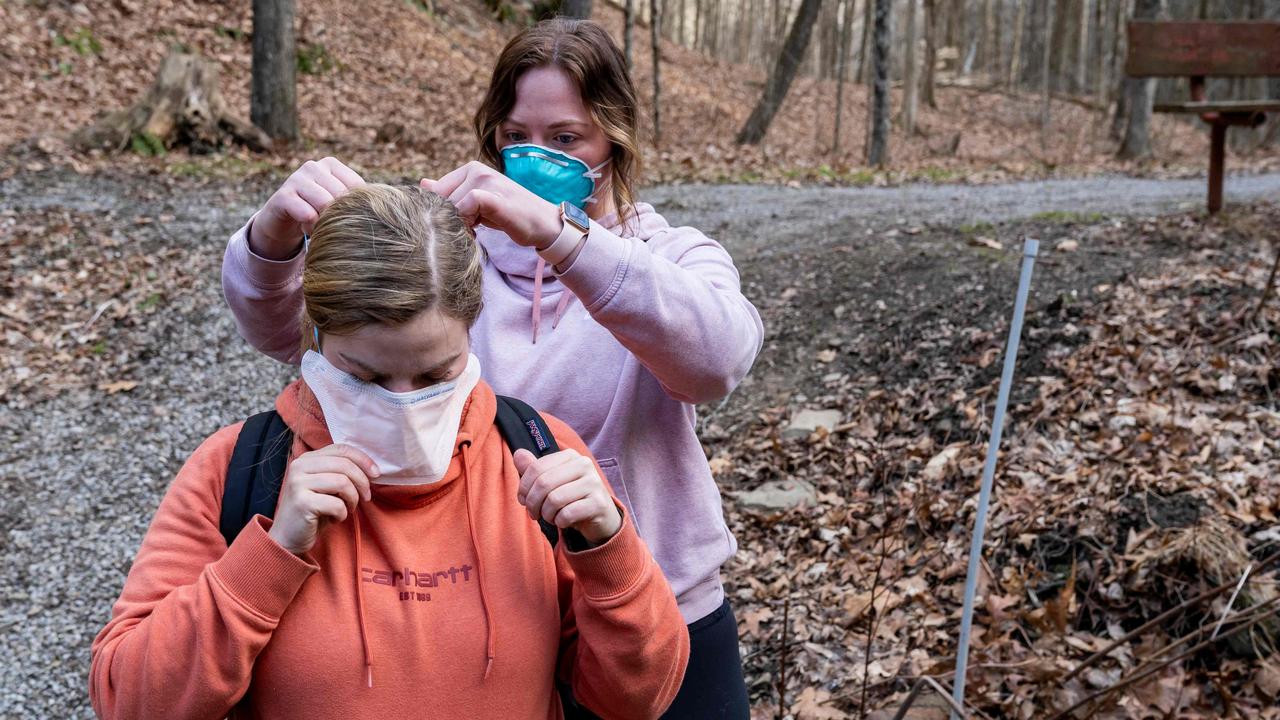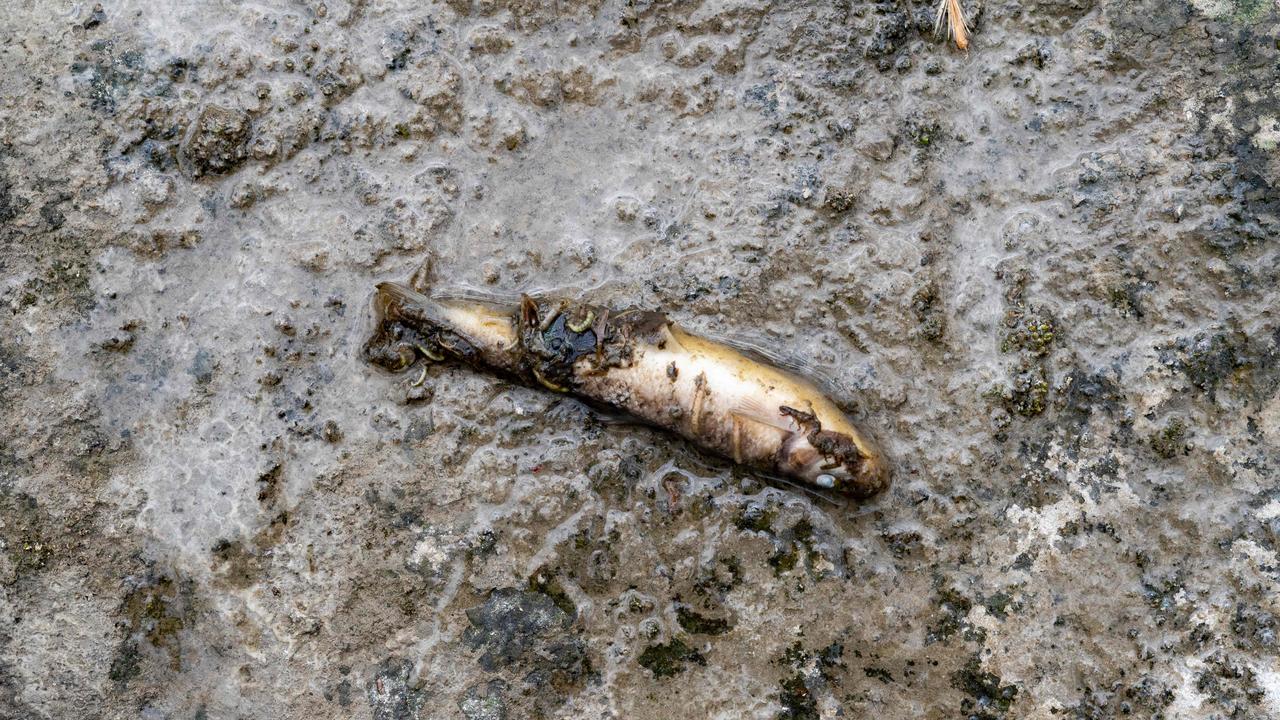‘Slowly dying’: Residents’ weird symptoms weeks after train derailment and explosion
Residents of an American town report they’re coming down with strange illnesses weeks after a disaster happened nearby.

Ohio man Wade Lovett’s been having trouble breathing since the February 3 Norfolk South train derailment and toxic explosion. In fact, his voice sounds as if he’s been inhaling helium.
“Doctors say I definitely have the chemicals in me but there’s no one in town who can run the toxicological tests to find out which ones they are,” Lovett, 40, an auto detailer, told the New York Post in an extremely high-pitched voice.
“My voice sounds like Mickey Mouse. My normal voice is low. It’s hard to breathe, especially at night. My chest hurts so much at night I feel like I’m drowning. I cough up phlegm a lot. I lost my job because the doctor won’t release me to go to work.”
Despite his health woes, Mr Lovett and his fiancee, Tawnya Irwin, 45, spent last Thursday delivering bottled water to locals who have been impacted since a train derailed in their town of East Palestine, Ohio. The incident caused toxic chemicals to be released into the air and the immediate sickness and deaths of animals nearby.
The couple picked up new cases outside a home on East Clark Street which has become the heart of East Palestine’s homegrown campaign to fight back against the forces that up-ended the lives of roughly 4700 residents and their animals.


Locals are frustrated and furious over what they say has been a lack of real information and help from both local officials and the Biden Administration. Last week, East Palestine Mayor Trent Conaway ripped Mr Biden for heading to Ukraine for a surprise visit instead of the scene of the toxic train derailment, calling it “the biggest slap in the face”.
Leading the charge to fight for the community is 46-year-old Jami Cozza, a lifelong East Palestinian who counts 47 close relatives here. Many of them are facing health issues from the chemical fire as well as the psychic toll of their town becoming, in the words of a scientist visiting the area on Thursday, the new “Love Canal” — a reference to the Niagara Falls, New York, neighbourhood that became a hotbed issue in 1978 because people were getting sick from living above a contaminated waste dump.
Although famed environmental activist Erin Brockovich held a town hall on Friday night, many locals say the fierce and forceful Ms Cozza beat her to the punch.

“I’ve known Jami my whole life and she is very sharp,” Jason Trosky, 47, a lifelong East Palestine resident, told The Post. “We’re lucky to have her. Brockovich came with her lawyer in tow. Will she help? Maybe, but she’s also trying to stay relevant. Jami will be here for us after the circus leaves town.”
Ms Cozza, 46, who’s lived in this small Ohio Valley village near the Pennsylvania border for most of her life, has her work cut out for her.
Her eyes fill with tears when she talks about how her 91-year-old widowed grandmother tried to clean the chemicals off the furniture in the house she’s lived in for 56 years — before giving up and moving to a hotel room where she can’t sleep at night.

Evacuation orders were lifted on February 8, but many locals say they got unexplained rashes and sore throats when they returned home. The creeks that dot the town still ripple with the telltale rainbow colour of contamination if you throw a rock in them.
An independent analysis by Texas A & M University of Environmental Protection Agency data, released on Friday, found nine air pollutants at levels that could raise long-term health concerns in and around East Palestine, apparently contradicting statements by state and federal regulators that the air there is safe.
“My fiance was so sick that I almost took him to the hospital,” Ms Cozza told The Post while sitting on the porch of her aunt’s home on East Clark Street a few hours before she led her own town hall meeting on Thursday.

“Not only am I fighting for my family’s life, but I feel like I’m fighting for the whole town’s life. When I’m walking around hearing these stories, they’re not from people. They’re from my family. They’re from my friends that I’ve have grown up with,” she said. “People are desperate right now. We’re dying slowly. They’re poisoning us slowly.”
Though President Donald Trump, Transportation Secretary Pete Buttigieg, former US Representative Tulsi Gabbard, and Brockovich visited East Palestine in the past week, Ms Cozza and other residents said they know the media spotlight will fade. She’s determined to keep the pressure on once her town becomes old news.
A big part of Jami and the town’s battle involves questions over whether Norfolk Southern’s decision to effectively nuke the town with deadly chemicals in what they called a “controlled explosion” was the correct one — or if they were just cheaper than cleaning up the mess on the ground.

A class-action suit filed on behalf of hundreds of residents alleges that Norfolk Southern went rogue when it decided to blow up the cargo in five train cars containing deadly vinyl chloride three days after the derailment, effectively poisoning the town and nearby region. About 1.1 million pounds of toxic vinyl chloride were spilt and later burned, sending thick, black plumes of smoke into the air and contaminating soil and water sources, the suit claims.
A spokesman for Norfolk Southern told The Post that the company consulted experts including Governor Mike DeWine after discovering, two days after the crash, that the pressure relief devices in one train car had stopped working. He also said it had to take action in the form of a controlled burn to avoid what the company called a potential “catastrophic failure of the cars.”
The National Safety Transportation Board report backs up Norfolk Southern’s description of the rising temperature in the one train car and why the company decided to explode the chemicals over East Palestine.
But there are many who wonder if there was a better way.
“The company’s decision was very suspicious,” Rene Rocha of the Morgan & Morgan law firm and one of the lead lawyers on the class-action case told The Post. “Norfolk Southern discharged more vinyl chloride into a small area in eastern Ohio in a day than the entire industries combined of America discharge in a year.”

Ms Rocha also said that the state of Ohio has eliminated punitive damages so that the most Norfolk Southern would be ordered to pay the residents of East Palestine would be a total of $US350,000 ($520,000). Norfolk Southern countered by saying it has already shelled out $US8 million ($12 million) in aid to the town, including controversial $US1000 ($1590) checks paid to residents as well as money for new equipment, a community fund, and the cost of preliminary testing of the town and its residents. (The company is worth $US51 billion, or $75.8 billion.)
“What they could have done and should have done is remove all the vinyl chloride from the train cars and put them in secure containment vessels,” Ms Rocha said. “They then should have excavated tons of soil and monitored and remediated the soil and groundwater.”
The railway company repaired the train tracks, put some new gravel on top, and began running trains one day after the so-called “controlled” explosion.
Ms Cozza and the hundreds of residents at a town hall organised by Ms Cozza and River Valley Organizing have not been impressed by the railway company’s efforts to help the town — particularly the $1000 checks, which several residents told The Post they only got after signing something saying they would not ask for more.
“I don’t care if you hate me because I beat you up years ago or not,” Ms Cozza told the town meeting underneath a big sign reading “Make Norfolk Southern Pay!’”
“We have to put all our differences aside and show the world we are East Palestine Strong. We are at war with corporate greed. We need accountability and we need answers. We are here to make our town safe. And by the way, don’t tell us we’re aren’t getting sick, that it’s all in our head. We are getting sick.”

Ms Cozza’s hearing included a panel with scientists from the University of Pittsburgh, an environmental lawyer, and a veteran Ohio hazardous materials expert. None of them painted a rosy picture of the town’s future, despite Norfolk Southern’s insistence that the area is safe and will be cleaned up and tested more.
The experts listened as desperate residents asked about the safety of breastfeeding their babies and getting water from their wells. Planting season is coming soon in an area where many farms. One woman cried when she spoke about her worry over her pregnant goats.
Stephen Lester, a Harvard-trained toxicologist at the Center for Health, Environment and Justice with 40 years of experience, said the hot zone at East Palestine was among the most concerning he has ever seen — and stressed the dangers of the chemical dioxin that was released during the controlled burn and that will be embedded in the soil and water.
“Until the government takes this seriously there are going to be real problems,” he said. “It’s criminal that the EPA didn’t come forward with information about dioxin and start testing for it.”
Jason Trosky, a telecom project manager, told The Post he is one of the lucky ones in town. His mortgage is paid off and he has enough money to move his family to an apartment outside the red zone where his house sits. He, like many others, worries about people like Shelby Walker and her family, who live in a house a few yards from the epicentre of the crash and explosion and cannot afford to move even though they feel sick.
“The bad smell comes and goes,” Ms Walker said. “Yesterday was the first day in probably three or four days that I could smell anything. I lost my smell and my sense of taste. I had an eye infection in both eyes. I was having respiratory issues like I was just out of breath. Other members of my family have had eye infections and strep throat.
“The clean-up crew drives past us at night and won’t even look at us. It’s like we don’t exist. No one has reached out to us or told us anything.”
Cozza said she is determined to get answers.
“We’re not going to shut up,” she said. “We’re not weak but we need support. We’re here for the long run. Trump came here and then he was gone. What’s he going to do for us, really? We’re going to do it ourselves and we’re organising from the ground up.”
This article originally appeared on the New York Post and was reproduced with permission
Originally published as ‘Slowly dying’: Residents’ weird symptoms weeks after train derailment and explosion


